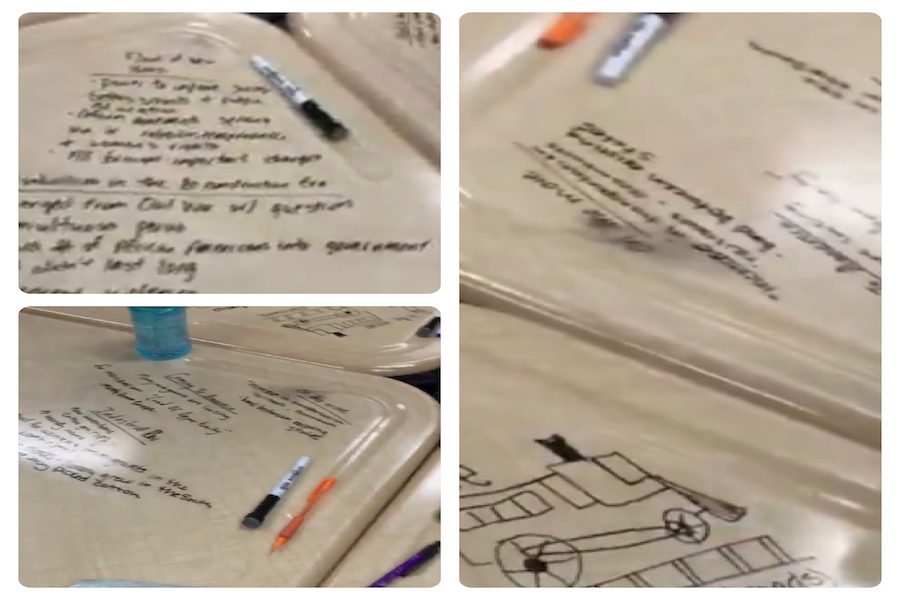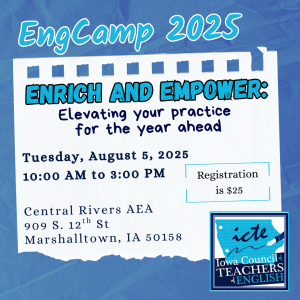Practice What You Preach: Start with Brainstorming
Are you writing? A teacher turns to the advice she gives her students to jumpstart her first contribution to ICTE Journal.
Students’ desks are transformed into whiteboards in Jennifer Hartwig’s classroom. Writing on desks invites students to “brain dump” their ideas, creating writing energy and momentum.
July 31, 2019
I try my best to practice what I preach – as a mother, a Christian, a teacher. This summer, in fact, I had every intention of practicing what I preach – or in this case teach: writing.
My writing was going to work in tandem with my 30+ year family photo collection which I was going to organize into an iPhoto book in which I would then write sweet, humorous narratives to memorialize the childhoods of my three grown children.
Well… June was stolen by a landscaping project, July was gladly given to the birth of my first grandbaby, and now my last month of summer vacation is staring me in the face, reminding me that I haven’t yet practiced what I preach.
I haven’t written.
Sigh. Roll my eyes. Slump my shoulders. Look at my phone. Go to the fridge. Peruse Facebook. Fight with myself internally about my inabilities. Sigh… again.
Suddenly, I realize I am practicing a perfect performance of my typical reluctant high school writers and then hear clearly running through my head: “Practice what you preach. Start with brainstorming.”
“Just start. Remember that you have lots of valuable ideas floating around in your head that you may not even realize are there. But you must start; get your writing momentum going. Try an idea dump: time yourself for 3-5 minutes and spit out everything that’s in your head. Force yourself to continue writing the entire time. See where your ideas go. Writing forces us to organize all those great thoughts we already have while also generating more ideas.”
So I’ll practice what I preach and start with brainstorming.
As a writing teacher, I’m big on brainstorming and facilitate numerous brainstorming techniques throughout the school year. So I decide to start with an idea dump. In the classroom, this is something I like to do with dry erase markers on desktops, but it can be done on paper or computer. However, students actually writing on their desks (then taking a picture of it with their phones if they’d like) is more freeing, strengthening the “dump” idea. They are able to randomly and quickly write or draw all the ideas they discover in their heads onto their desks however they come to their minds. Then they can organize those ideas by looking for patterns, similarities, and writing direction.
Once they’ve analyzed their idea dump, I oftentimes move to timed writing. This is one of my favorite brainstorming techniques because I’ve never seen it fail to show writing momentum – a key element of brainstorming and the writing process.
In timed writings, I either give students a prompt or direct them to choose one of their idea-dump categories. Then I put the timer on for two to four minutes during which writers are to continue writing the entire time. When the timer stops, they stop, draw a line, and count their words. Then we chart the number of words each student wrote. It sounds like, “OK, how many wrote 11-20 words? 21-30? How many with 31-40?” I chart the number of students who wrote X number of words. Then we start the timer again with either a new prompt, a continuation of the previous prompt, or an idea found in their previous timed writing (sometimes called looping). When the timer goes off, we count, chart the second timed writing, and start the process again for another two or three rounds. Inevitably, students see the trend line moving to the upper right corner of the chart, clearly demonstrating writing momentum.
Experiencing (individually and collectively) an increasing writing energy makes students and their ideas flourish. They seem driven by the timer. For one thing, it’s do-able – two measly minutes. Then when I have them count their words and start another two minutes of writing, their competition kicks in. Those who balk or stutter to start on the first round soon find their fingers clicking furiously on their keyboards, whether in competition with themselves or others. The writing energy in the classroom is palpable when students see our class word count climb higher with each consecutive timed writing – tangible proof that they’ve all got ideas in their heads that can be produced in writing, a fact I never miss pointing out.
Despite the fact that some of the most reluctant writers may use what they’ve just written as their baseline draft before assigned revisions, these writers did experience writing momentum, a necessary element in writing growth, and they’re now at least able to participate in class-wide revisions and peer reviews. Pleasantly, however, most writers will use this brainstorming as a solid launch pad for further content, organization, and revision on their own. And the more mature and motivated writers will use these texts as discovery drafts, analyzing them in order to spur on deeper idea generation, organization, and explorative revision.
Either way, brainstorming is vital to experiencing the writing momentum necessary to move writers into the next stages of the writing process. And it’s a good feeling to have practiced what I preach about writing and to have experienced for myself the energy produced by a number of different brainstorming techniques













